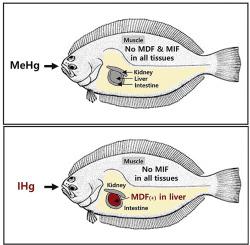Environmental Pollution ( IF 7.6 ) Pub Date : 2020-09-11 , DOI: 10.1016/j.envpol.2020.115588 Bong Joo Lee , Sae Yun Kwon , Runsheng Yin , Miling Li , Saebom Jung , Seung Hyeon Lim , Ju Hyeon Lee , Kang Woong Kim , Kyoung Duck Kim , Ji Won Jang

|
Mercury isotope ratios in fish tissues have been used to infer sources and biogeochemical processes of mercury in aquatic ecosystems. More experimental studies are however needed to understand the internal dynamics of mercury isotopes and to further assess the feasibility of using fish mercury isotope ratios as a monitoring tool. We exposed oliver flounder (Paralichthys olivaceus) to food pellets spiked with varying concentrations (400, 1600 ng/g) of methylmercury (MeHg) and inorganic mercury (IHg) for 10 weeks. Total mercury (THg), MeHg concentrations, and mercury isotope ratios (δ202Hg, Δ199Hg, Δ200Hg) were measured in the muscle, liver, kidney, and intestine of fish. Fish fed mercury unamended food pellets and MeHg amended food pellets showed absence of internal δ202Hg and Δ199Hg fractionation in all tissue type. For fish fed IHg food pellets, the δ202Hg and Δ199Hg values of intestine equilibrated to those of the IHg food pellets. Kidney, muscle, and liver exhibited varying degrees of isotopic mixing toward the IHg food pellets, consistent with the degree of IHg bioaccumulation. Liver showed additional positive δ202Hg shifts (∼0.63‰) from the binary mixing line between the unamended food pellets and IHg food pellets, which we attribute to redistribution or biliary excretion of liver IHg with a lower δ202Hg to other tissues. Significant δ202Hg fractionation in the liver and incomplete isotopic equilibration in the muscle indicate that these tissues may not be suitable for source monitoring at sites heavily polluted by IHg. Instead, fish intestine appears to be a more suitable proxy for identifying IHg sources. The results from our study are essential for determining the appropriate fish tissues for monitoring environmental sources of IHg and MeHg.
中文翻译:

海洋鱼类中无机和甲基汞的内部动力学:汞稳定同位素的见解
鱼组织中的汞同位素比率已用于推断水生生态系统中汞的来源和生物地球化学过程。但是,需要更多的实验研究来了解汞同位素的内部动力学,并进一步评估使用鱼类汞同位素比率作为监测工具的可行性。我们将奥利弗比目鱼(Paralichthys olivaceus)暴露于加有不同浓度(400,1600 ng / g)甲基汞(MeHg)和无机汞(IHg)的食物颗粒中,持续10周。总汞(THG),甲基汞浓度和汞同位素比率(δ 202汞柱,Δ 199汞柱,Δ 200Hg)在鱼的肌肉,肝,肾和肠中进行测量。鱼馈汞未修改的食物颗粒和甲基汞修正显示没有内部δ的食物颗粒202 Hg和Δ 199汞柱分馏在所有组织类型。对于鱼喂IIIg的食物颗粒,所述δ 202 Hg和Δ 199肠的汞值平衡至那些IIIg的食品的颗粒。肾脏,肌肉和肝脏对IHg食物颗粒的同位素混合程度不同,与IHg生物蓄积程度一致。肝脏表现出额外的正δ 202点从未经修正的食物颗粒和IIIg的食物颗粒之间的二进制混频线,这是我们归因于再分配或肝IIIg的胆汁排泄具有较低δ汞柱位移(~0.63‰)202 Hg对其他组织。显著δ 202在肝脏汞柱分馏和在肌肉不完全平衡同位素表明这些组织中可能不适合于在源通过IIIg的污染严重站点监测。相反,鱼肠似乎是鉴定IHg来源的更合适的替代物。我们的研究结果对于确定适当的鱼类组织以监测IHg和MeHg的环境来源至关重要。











































 京公网安备 11010802027423号
京公网安备 11010802027423号